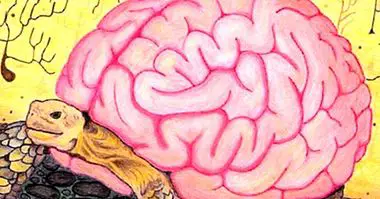Postformal thought: the development beyond Piaget
Jean Piaget described four stages of cognitive development : sensorimotor, preoperational, concrete operations and formal operations. Each of these periods is characterized by the use of progressively more complex cognitive operations.
Although this author affirmed that cognition reaches its final stage in adolescence, other theorists consider that there is also postformal thought , a fifth stage of cognitive development that is characterized by the ability to relativize, assume the contradiction and synthesize opposite elements.
- Related article: "The 4 stages of Jean Piaget's cognitive development"
The formal thought according to Piaget
For Jean Piaget, pioneer of evolutionary psychology and author of the most popular theory on cognitive development, it reaches its culmination when concrete thought is abandoned and formal thought is consolidated, that is, the ability to think abstractly.
This implies that when reaching this stage, which happens as a rule between 11 and 15 years, not only work with concrete elements, tangible and based on reality, but also with hypotheses and possibilities. In addition, skills are developed that allow adopting perspectives different from one's own.
Formal thinking has a hypothetical-deductive character , which overcomes the empiricism characteristic of the stage of concrete operations; In this way, reality becomes understood as a subset of the possible, unlike in the previous period, when the possible is seen as an extension of the real.
Piaget and his collaborator Bärbel Inhelder affirmed that formal thought is based on verbal statements (propositional thinking), rather than on concrete objects. Given that the flexibility of language is much greater than that of matter, this type of thinking greatly increases cognitive and communicative possibilities.
Subsequently, different authors questioned and qualified the concept original of formal thought. Thus, today it is believed that not all people reach this stage, that this can happen at any age and only in the tasks in which we specialize, and that there may be another type of reasoning that is even more advanced: postformal thought.
- Maybe you are interested: "Magical thinking: causes, functions and examples"
Characteristics of postformal thought
Representatives of different theoretical orientations, especially dialectical psychology and the life cycle, have proposed the existence of postformal or dialectical thought, which is conceptualized as a stage subsequent to that of formal operations.
Unlike formal, postformal thinking it would allow to integrate the subjective, the emotional and the symbolic with the logical, analytical and objective components of the previous period. As a result there would be a complexity of cognitive operations, which would work less literally and rigidly than in the case of formal thinking.
Three basic characteristics of postformal thought have been described: the relativism of knowledge, the acceptance of contradiction and the synthesis between discordant elements.
1. Relativism
Formal thinking tends to be dichotomous; thus, for example, people are usually categorized as "good" or "bad", and affirmations are understood as absolute truths or as lies, without intermediate points.
However, the interaction with other people, the adoption of multiple roles and the acquisition of new information favor the awareness that there are multiple truths that depend on the point of view , very influenced by personal history, and the context from which they are observed.
Thus, this tendency does not pay as much attention to what is supposed to be "the truth", and the focus is on the type of narratives that are adopted to explain it.
2. Contradiction
Once the relativistic thought appears, the contradiction is accepted as a natural aspect of life. Apparently incompatible phenomena can coexist, both in the perception of reality and in living beings and objects.
Thus, any person can be "good" and "bad" simultaneously, continuing with the previous example. The complex nature of reality is accepted, and the idea that there are different ontological realities that overlap is internalized.
Several authors defend that the acceptance of contradiction is the most characteristic feature of adult thinking, and that usually develops during middle age . However, the interindividual variability is high, so it can also happen sooner or later.
3. Synthesis or dialectic
Since they assume relativism and contradiction as natural aspects of human experience, people who use postformal thought can integrate (or synthesize) contradictory mental content, both cognitively and emotionally.
During this stage there is a continuous dialectic in thought, so that all ideas are compared and synthesized with their opposite and with other different experiences. This allows for a higher and more flexible reasoning capacity than that which characterizes formal thinking.
- Maybe you're interested: "The Cognitive Theory of Jerome Bruner"
Stage of development or style of thinking?
Although those who defend the concept of postformal thought usually define it as a stage of cognitive development that, as the name suggests, appears after the stage of formal operations, for the moment scientific research has not confirmed this hypothesis .
Although it is true that the defining characteristics of postformal thought are manifested more frequently the higher the age, not all people who develop normally reach this cognitive period. In fact, not even everyone can move from the stage of concrete operations to that of formal ones.
In addition, scientific evidence shows that some people who have not reached the formal period show a relativistic thinking. It has been hypothesized, therefore, that postformal thinking is a style of reasoning consisting of a set of Metacognitive skills that can be acquired after maturation , and not necessarily a stage of development.



















